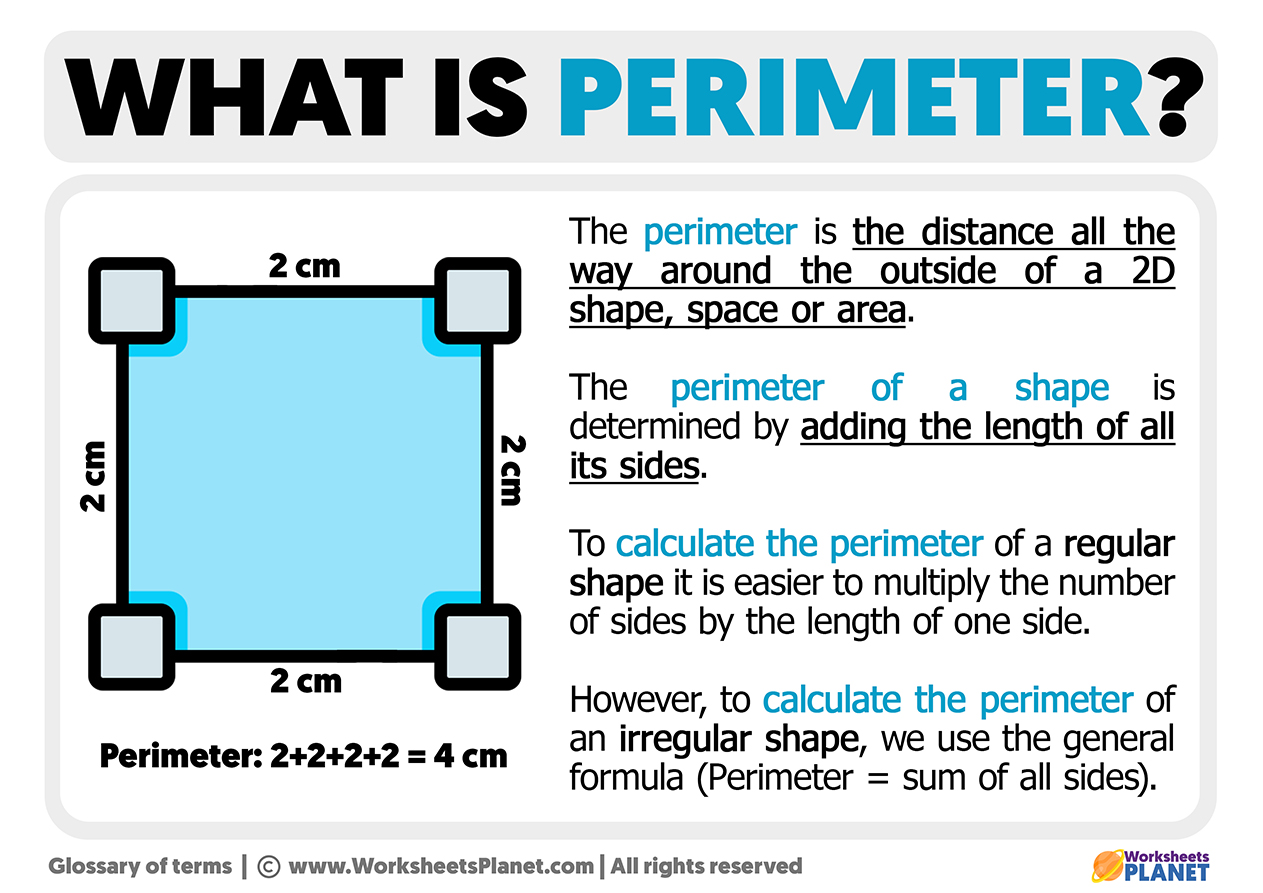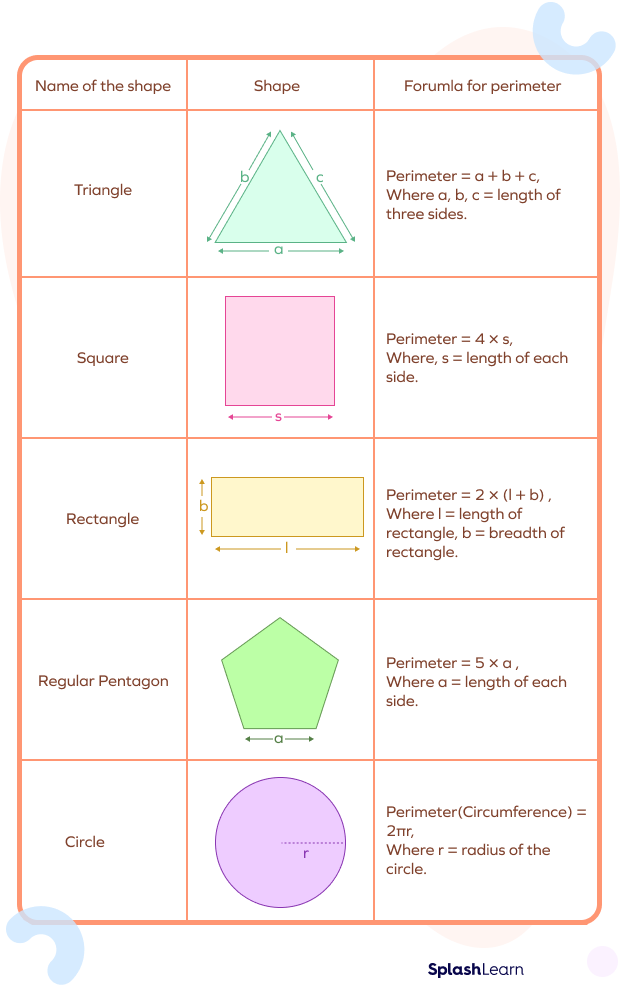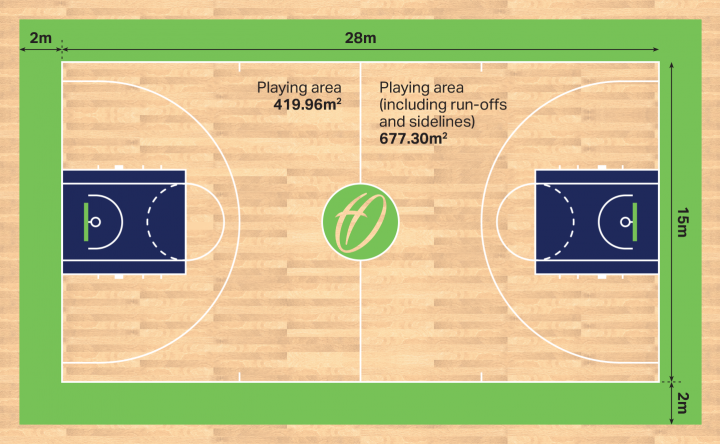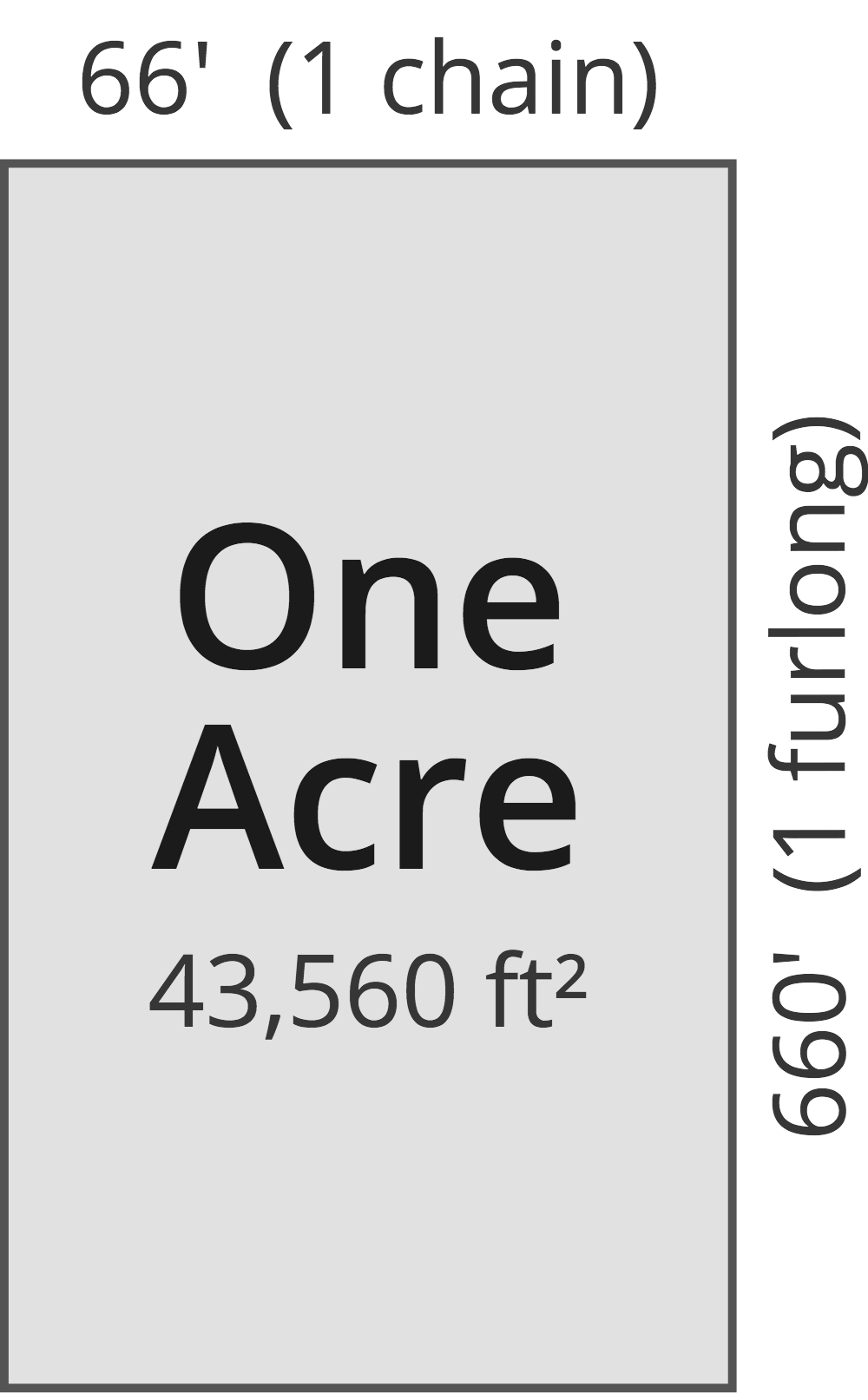Topic perimeter is: Perimeter is a fundamental concept in geometry, defining the total distance around a two-dimensional shape. Understanding perimeter helps in various real-world applications, from fencing properties to framing pictures. This article explores the basics of perimeter, its formulas for different shapes, and practical examples to enhance your comprehension and application of this essential mathematical concept.
Table of Content
Understanding Perimeter
The perimeter is the total distance around a two-dimensional shape. It is calculated by adding together the lengths of all the sides of the shape. Below, we outline the formulas and examples for finding the perimeter of various geometric figures.
Perimeter Formulas
- Square: \( P = 4s \) where \( s \) is the length of a side.
- Rectangle: \( P = 2l + 2w \) where \( l \) is the length and \( w \) is the width.
- Equilateral Triangle: \( P = 3s \) where \( s \) is the length of a side.
- Regular Polygon: \( P = ns \) where \( n \) is the number of sides and \( s \) is the length of a side.
- Circle (Circumference): \( C = 2\pi r \) where \( r \) is the radius.
Examples
Let's consider some examples to understand how to calculate the perimeter:
- Rectangle: For a rectangle with length 7 cm and width 3 cm, the perimeter is \( 2(7 + 3) = 20 \) cm.
- Square: For a square with each side measuring 4 cm, the perimeter is \( 4 \times 4 = 16 \) cm.
- Circle: For a circle with a radius of 5 cm, the circumference is \( 2\pi \times 5 = 10\pi \) cm.
Applications of Perimeter
Perimeter is widely used in various real-life situations such as:
- Determining the amount of fencing required to enclose a yard.
- Calculating the length of trim needed to go around a window or door.
- Finding the boundary length for a garden bed to install an edging.
Perimeter of Irregular Shapes
For irregular shapes, the perimeter is still the sum of all its sides. Use a ruler for small shapes, or a string to measure and then find the length of the string.
Distance Formula for Polygons
If the vertices of a polygon are known, the side lengths can be calculated using the distance formula:
\[
d = \sqrt{(x_2 - x_1)^2 + (y_2 - y_1)^2}
\]
This helps in determining the perimeter by summing the lengths of all sides.
Units of Perimeter
The units of perimeter are the same as the units used for measuring lengths, such as meters, centimeters, inches, or feet.
Understanding and calculating perimeter is essential in geometry and has practical applications in everyday life.

READ MORE:
Introduction to Perimeter
The perimeter is the total distance around the boundary of a two-dimensional shape. It is an essential concept in geometry, used to determine the length of the boundary of various geometric figures such as triangles, squares, rectangles, circles, and polygons.
To calculate the perimeter, you sum the lengths of all the sides of the shape. This simple principle applies to both regular and irregular shapes. For instance:
- Square: The perimeter is given by \( P = 4s \) where \( s \) is the length of a side.
- Rectangle: The perimeter is calculated as \( P = 2(l + w) \) where \( l \) is the length and \( w \) is the width.
- Triangle: The perimeter is the sum of its three sides, \( P = a + b + c \).
- Circle: The perimeter, known as the circumference, is \( C = 2\pi r \) where \( r \) is the radius.
- Regular Polygon: The perimeter is \( P = ns \) where \( n \) is the number of sides and \( s \) is the length of each side.
In real-world applications, calculating the perimeter is crucial for tasks such as fencing a property, framing pictures, or designing a layout for a garden. Understanding the perimeter helps in planning and executing these tasks efficiently.
For irregular shapes, the process involves measuring each side's length and then summing these measurements. This can be done using tools such as rulers for straight edges or strings for curved boundaries.
Overall, the concept of perimeter is foundational in geometry and has diverse applications in everyday life and various fields such as construction, art, and landscaping.
Definition and Basic Concepts
The perimeter is the total length around the boundary of a two-dimensional shape. It is a fundamental concept in geometry that applies to various shapes, including polygons, circles, and more complex figures.
To understand perimeter, consider the following key points:
- Perimeter of a Polygon: The perimeter is calculated by adding the lengths of all the sides. For example, the perimeter of a rectangle with length \( l \) and width \( w \) is given by: \[ P = 2l + 2w \] Similarly, for a square with side length \( a \), the perimeter is: \[ P = 4a \]
- Circumference of a Circle: For a circle, the perimeter is referred to as the circumference, calculated using the radius \( r \): \[ C = 2\pi r \]
- Regular Polygons: For regular polygons (where all sides are equal), the perimeter can be calculated by multiplying the number of sides \( n \) by the length of one side \( s \): \[ P = ns \]
In practice, calculating the perimeter involves straightforward addition of side lengths for polygons, while for circles and more complex shapes, specific formulas are used. Understanding these concepts is essential for various real-world applications, such as determining the amount of material needed to enclose a space or the length of trim required for a project.
Units of measurement for perimeter are the same as those used for length, such as meters, centimeters, feet, or inches. This consistency helps in practical applications, making it easier to measure and calculate the perimeter of different shapes.
In summary, the perimeter is a simple yet crucial concept in geometry that measures the total distance around a shape, providing valuable information for both theoretical and practical purposes.
Perimeter Formulas for Different Shapes
Perimeter is the total distance around the boundary of a two-dimensional shape. The formula to calculate the perimeter varies depending on the shape. Below are the formulas for different geometric shapes:
- Square:
The perimeter of a square is calculated by multiplying the length of one side by 4.
\[ P = 4a \] where \( a \) is the length of a side. - Rectangle:
The perimeter of a rectangle is the sum of all its sides, or twice the sum of its length and width.
\[ P = 2(l + w) \] where \( l \) is the length and \( w \) is the width. - Triangle:
The perimeter of a triangle is the sum of the lengths of its three sides.
\[ P = a + b + c \] where \( a, b, \) and \( c \) are the side lengths. - Circle:
The perimeter of a circle is called the circumference and is calculated using the radius.
\[ C = 2\pi r \] where \( r \) is the radius. - Regular Polygon:
For a regular polygon (all sides are equal), the perimeter is the product of the number of sides and the length of one side.
\[ P = ns \] where \( n \) is the number of sides and \( s \) is the length of one side. - Parallelogram:
The perimeter of a parallelogram is the sum of the lengths of its sides, or twice the sum of its adjacent sides.
\[ P = 2(a + b) \] where \( a \) and \( b \) are the lengths of adjacent sides. - Ellipse:
The perimeter of an ellipse is more complex to calculate and often approximated as:
\[ P \approx \pi \left( 3(a + b) - \sqrt{(3a + b)(a + 3b)} \right) \] where \( a \) and \( b \) are the semi-major and semi-minor axes, respectively.
Understanding these formulas helps in various applications, such as determining the length of materials needed to outline a shape or the fencing required for a property. Each formula is derived based on the unique properties and dimensions of the shape it applies to.
How to Find Perimeter
Finding the perimeter of a shape involves calculating the total length of its boundary. This process varies depending on whether the shape is regular (all sides and angles are equal) or irregular. Here are detailed steps and examples for finding the perimeter of different shapes:
- Regular Shapes:
For regular shapes, such as squares and equilateral triangles, you can use simple multiplication because all sides are equal.
- Square:
To find the perimeter of a square, multiply the length of one side by 4:
\[ P = 4s \] where \( s \) is the length of a side. - Equilateral Triangle:
The perimeter is three times the length of one side:
\[ P = 3s \] where \( s \) is the length of a side. - Regular Polygon:
For a regular polygon with \( n \) sides, each of length \( s \), the perimeter is:
\[ P = ns \]
- Square:
- Irregular Shapes:
For irregular shapes, you need to add the lengths of all sides individually.
- Triangle:
Add the lengths of all three sides:
\[ P = a + b + c \] where \( a, b, \) and \( c \) are the side lengths. - Quadrilateral:
Sum the lengths of all four sides:
\[ P = a + b + c + d \] where \( a, b, c, \) and \( d \) are the side lengths.
- Triangle:
- Circle (Circumference):
The perimeter of a circle is called the circumference, calculated using the radius:
\[ C = 2\pi r \] where \( r \) is the radius.
For more complex shapes, such as ellipses or sectors, specific formulas are used. For example, the perimeter of an ellipse is more complicated and often approximated. Additionally, you can find the perimeter of a sector using the radius and angle.
In practical applications, you might use a ruler for straight edges or a string for curved boundaries. The key is to measure accurately and sum the lengths to get the total perimeter. Understanding these methods allows you to apply perimeter calculations to various real-life scenarios, such as fencing a yard, framing a picture, or outlining a garden.

Examples and Practice Problems
Practicing perimeter calculations helps solidify understanding and allows application of formulas in various contexts. Here are detailed examples and practice problems for different shapes:
Example 1: Perimeter of a Rectangle
Given a rectangle with a length of 7 cm and a width of 3 cm, calculate its perimeter.
- Formula: \( P = 2(l + w) \)
- Calculation: \( P = 2(7 + 3) = 2 \times 10 = 20 \) cm
Example 2: Perimeter of a Square
Given a square with each side measuring 5 cm, calculate its perimeter.
- Formula: \( P = 4s \)
- Calculation: \( P = 4 \times 5 = 20 \) cm
Example 3: Perimeter of a Circle
Given a circle with a radius of 7 ft, calculate its perimeter (circumference).
- Formula: \( C = 2\pi r \)
- Calculation: \( C = 2 \times \pi \times 7 = 14\pi \approx 44 \) ft
Example 4: Perimeter of an Irregular Shape
Given an irregular pentagon with sides measuring 2 cm, 3 cm, 3 cm, 4 cm, and 5 cm, calculate its perimeter.
- Formula: \( P = a + b + c + d + e \)
- Calculation: \( P = 2 + 3 + 3 + 4 + 5 = 17 \) cm
Practice Problems
- Calculate the perimeter of a rectangle with a length of 8 m and a width of 6 m.
- Find the perimeter of an equilateral triangle with each side measuring 9 cm.
- Determine the perimeter of a circle with a diameter of 10 inches.
- Calculate the perimeter of a regular hexagon with each side measuring 4 inches.
- Find the perimeter of an irregular quadrilateral with sides measuring 4 m, 5 m, 6 m, and 7 m.
By working through these examples and practice problems, you will enhance your ability to accurately calculate the perimeter of various shapes and apply these skills to real-world situations.
Real-World Applications of Perimeter
The concept of perimeter is not only fundamental in geometry but also has numerous practical applications in everyday life. Understanding how to calculate the perimeter can help in various real-world scenarios:
- Fencing and Borders:
When you need to install a fence around a garden, yard, or any property, knowing the perimeter helps you determine the total length of fencing material required. For example, if you have a rectangular garden that measures 20 meters by 10 meters, the perimeter is:
\[ P = 2(l + w) = 2(20 + 10) = 60 \text{ meters} \] - Home Improvement Projects:
Perimeter calculations are essential when adding trim or molding around walls, doors, or windows. This ensures you purchase the correct amount of material and avoid shortages or excess.
- Sports Fields:
In sports, calculating the perimeter of fields and courts is important for setting up boundaries. For instance, a standard soccer field might have a length of 100 meters and a width of 60 meters, giving a perimeter of:
\[ P = 2(l + w) = 2(100 + 60) = 320 \text{ meters} \] - Construction:
Builders and architects use perimeter measurements to estimate materials needed for the construction of buildings, roads, and other structures. For example, determining the perimeter of a rectangular building foundation helps in estimating the length of the wall materials required.
- Decorations:
When decorating, such as putting up lights around a window or wrapping ribbon around a box, knowing the perimeter ensures you have the right length of material. For a circular table with a radius of 2 meters, the perimeter (circumference) is:
\[ C = 2\pi r = 2\pi \times 2 = 4\pi \approx 12.57 \text{ meters} \]
Understanding and applying the concept of perimeter allows for efficient planning and execution of a variety of projects, saving time and resources by ensuring precise measurements.
Interactive Exercises and Quizzes
Engage with a variety of interactive exercises to test your understanding of perimeter. These activities are designed to reinforce learning through practical application and immediate feedback. Below are some interactive exercises and quizzes you can try:
Basic Perimeter Exercises
- Calculate the perimeter of various simple shapes, such as squares, rectangles, and triangles.
- Find the missing side length when the perimeter is given.
- Identify and correct errors in perimeter calculations.
Interactive Quizzes
Test your knowledge with these quizzes:
- Basic Perimeter Quiz
- Identify the perimeter of given shapes.
- Calculate perimeter from provided side lengths.
- Advanced Perimeter Quiz
- Solve problems involving the perimeter of composite shapes.
- Explore the relationship between perimeter and area.
Interactive Tools and Games
Make learning fun with these interactive tools and games:
- Geoboard Activities: Use virtual geoboards to create shapes and calculate their perimeters.
- Perimeter Explorer: Experiment with different shapes and dimensions to understand how perimeter changes.
- Perimeter Puzzles: Solve puzzles that challenge you to find the perimeter of irregular shapes.
Step-by-Step Practice Problems
| Shape | Problem | Solution |
|---|---|---|
| Rectangle | Find the perimeter of a rectangle with length 8 cm and width 5 cm. | \( P = 2l + 2w = 2(8) + 2(5) = 26 \) cm |
| Square | Find the perimeter of a square with side length 6 cm. | \( P = 4s = 4(6) = 24 \) cm |
| Triangle | Find the perimeter of a triangle with sides 7 cm, 9 cm, and 5 cm. | \( P = a + b + c = 7 + 9 + 5 = 21 \) cm |
Additional Resources
For more exercises and quizzes, explore online resources like Khan Academy and Math Interactive. These platforms offer a wealth of interactive content and personalized quizzes to enhance your learning experience.
Advanced Concepts and Theories
Diving deeper into the concept of perimeter involves exploring its applications and relationships with other geometric properties. Here, we will cover a few advanced topics to enhance your understanding:
Composite Shapes
To find the perimeter of composite shapes, break down the shape into simpler components such as rectangles, triangles, or circles. Calculate the perimeter of each component and then sum them up.
Example:
- Identify the simpler shapes within the composite shape.
- Calculate the perimeter of each shape.
- Add the perimeters to get the total perimeter of the composite shape.
Perimeter and Area Relationship
While perimeter measures the distance around a shape, the area measures the space within it. Understanding their relationship can help in various applications like optimizing materials or space.
Example:
- For a fixed perimeter, different shapes can have different areas. For instance, among all shapes with the same perimeter, a circle has the maximum area.
- For a fixed area, different shapes can have different perimeters. For example, among rectangles with the same area, a square has the minimum perimeter.
Perimeter in Higher-Dimensional Spaces
In higher-dimensional spaces, perimeter concepts extend to boundaries of three-dimensional objects.
Example:
- Surface Area: The perimeter of a three-dimensional object can be thought of as the sum of the lengths of its edges. For example, the surface area of a cube is calculated by summing the perimeters of its faces.
Perimeter of Fractal Shapes
Fractals are complex shapes where each part resembles the whole. Calculating the perimeter of fractals involves iterative processes and can lead to infinite perimeters for certain shapes like the Koch snowflake.
Example:
- The Koch snowflake is created by repeatedly adding smaller equilateral triangles to each side. As the process continues, the perimeter increases infinitely.
Interactive Exercises
Engage with the following interactive exercises to deepen your understanding of advanced perimeter concepts:
- Decompose composite shapes and calculate their perimeters.
- Explore the relationship between perimeter and area through practical problems.
- Analyze three-dimensional objects and determine their surface areas.
- Experiment with fractal shapes and observe how their perimeters evolve.

Toán Học Vui - Chu Vi















